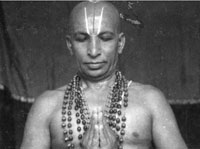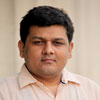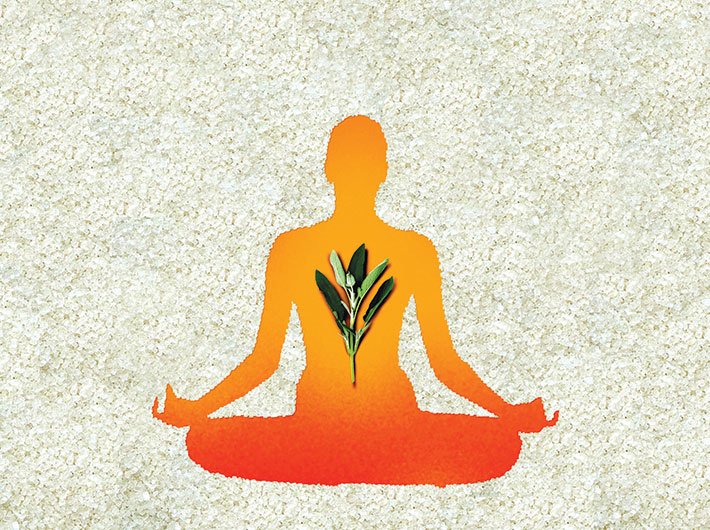A nationwide experiment on using yoga against diabetes shows immense promise. It could save India millions of healthcare rupees and improve productivity
There is nothing overblown about the alarm over diabetes in India.
One of every five diabetics in the world is an Indian.
Every six seconds, an Indian dies of complications related to diabetes. In those six seconds, two more Indians are diagnosed with the disease.
In 2003, 61.3 million Indians were diabetic. If preventive measures are not taken, the figure might rise to 101.2 million by 2030.
The disease is caused by a cluster of factors, calling for a multi-pronged approach. This is true for societies as for individuals. Allopathy shoots at direct causes and symptoms. Traditional healing systems like ayurveda look at health and disease holistically. The two systems can together forge a formidable synergy. A new central government initiative aims to deploy the combination to quench the diabetes epidemic. If it works, India might avoid the dire prediction that the country will by 2025 be the diabetes capital of the world.
On June 21, 2016, the second international yoga day, prime minister Narendra Modi gave a call for halting India from becoming the diabetes capital of the world. He said all yoga and ayurveda institutions should join hands and work in conjunction to achieve that goal. This call was taken up in right earnest with the formation of the Indian Yoga Association (IYA) in November 2016: many institutions came together under the initiative, the ministry of AYUSH set up a national committee of experts in yoga and diabetes to work out the full details. On the committee are Dr HR Nagendra, serving chairman of S-VYASA (Swami Vivekananda Yoga Anusandhana Samsthana), Bengaluru; Dr Manoj Nesari, an advisor to the AYUSH ministry; Dr Subodh Tiwari, director of Kaivalyadham, a yoga institute in Lonavale; Dr Ranjani Harish, a senior scientist at Mohan’s Diabetes Foundation; Dr Nikhil Tandon, head of the endocrinology & metabolism department of AIIMS, Delhi; and Dr Shirley Telles, director of research at the Patanjali institute, Haridwar.
A huge pan-Indian experiment on the use of yoga against diabetes was thus begun. At first, a population needed to be chosen for screening. In all 30 units – states and UTs – were identified, clubbing those with low populations with neighbouring units. Districts were randomly chosen from these units, one out of every ten. In all that made for 60 districts across India, from each of which 4,000 people aged 20 to 60 years were selected for screening (total 2.4 lakh). Further stratification was introduced to include selection of pre-diabetics and diabetics at the village and town/city level to create (a) ‘control’ groups and (b) groups that were given yoga training. Such groups were created for the study in cities too. At the village level, this was how the selection was made: four villages per district, two chosen for establishing control groups and two for groups that were put through yoga. It was ensured that the control group villages and the yoga group villages were at least 25 km away from each other. Each village contributed 20 pre-diabetics and 20 diabetics. In the bigger towns/cities, 2,000 people were chosen from one part and another 2,000 from another part far away from the first to make for control groups and yoga groups.
It was from this screening population of 2.4 lakh that the final set of about 48,000 persons were selected for the study. About 1,200 yoga instructors were required to conduct the screening. And they were trained in November 2016 to conduct screening and report to experts. Screening was conducted after that, and extended to mid-January 2017. In the end, 24,000 diabetics and 24,000 pre-diabetics were chosen. (Per district, 400 pre-diabetics and 400 diabetics formed part of the experiment.) Of the diabetics, 12,000 were kept in the control group and 12,000 in the yoga group; similarly, the 24,000 pre-diabetics were equally divided into the control and yoga groups. Then the experiment finally began, and ran over a period of three months – February, March, and April.
Twenty yoga instructors were assigned per district, where camps were run for nine days. Each instructor had to attend to 20 persons from the non-yoga group and 20 persons from the yoga group. In addition there were 35 senior research fellows for the project – around one for each regional unit (state or UT). These senior research fellows had to report to two national level research associates – Dr Amit Singh and Dr Rajesh SK. There were state-level technical committees to monitor the progress at every stage and give adequate support for the successful implementation of the programme. Right at the top was a national level committee of the Indian Yoga Association, which supported and advised all state-level committees in administering the programme and monitoring progress.
Those in the yoga group were put through a detailed regimen of exercise, relaxation and breathing techniques, diet recommendations and so on. There were follow-up sessions, each of two hours’ duration. During the rest of the week, the instructors would check on how the participants practised what was taught and collected data. By the end of April 2017, all data was gathered and by May-end, it was analysed and reports were written up.
The findings, according to those who conducted the study, were astounding. Those who were put through yoga showed tremendous improvement: full-blown diabetics improved to pre-diabetic stage and pre-diabetics become totally cured. In fact, many could stop taking medicine. However, in the control groups – which took medicine and exercise advice normally given to diabetics – there was no change, or their condition worsened.
“Yoga helps in systemic homoeostasis,” says Dr Amit Singh, who was a national-level research associate in the programme. “As a result it prevents retinopathy, neuropathy and nephropathy. Thus yoga helps in prevention and it helps in improvement of lifestyle of the people. Yoga is the ultimate tool to cure diabetes and this is what we have observed in our research across the length and breadth of the country.”
How allopathy looks at diabetes
At the heart of the matter is the difference between how allopathy and traditional systems of medicine, like ayurveda, look at the disease. Allopathy relates diabetes to a pancreatic hormone called insulin. In Type 1 diabetes, the body does not produce insulin; in Type 2 diabetes, the body is unable to use insulin efficiently.
Most hormonal or enzyme systems involve antagonistic pairs. Insulin is paired with glucagon. The alpha cells of the pancreatic islets (or islets of Langerhans) produce glucagon, while its beta cells produce insulin. The normal blood glucose level is 80-150 mg/decilitre, which is maintained by the two hormones working together. When blood glucose levels rise, insulin is released to bring down the level by transporting glucose to the cells; and when blood glucose levels fall, glucagon encourages the conversion of glycogen (animal starch) in the liver to glucose so that the body can use it for its energy needs.
In recent decades, though, allopathy has begun to take a more nuanced view. Genetics matters, of course, and it influences how much insulin one’s body produces and how it uses insulin. South Asians, Pacific islanders, Latinos and native Americans, for instance, are genetically predisposed to Type 2 diabetes. But rather than as just non-production of insulin, allopathy has started looking at diabetes as inefficiency in the insulin-glucagon mechanism. Diet, lifestyle, lack of exercise, and, most importantly, stress – these are factors that uspet the homoeostasis. Most cases of urban diabetes are related to these rather than genetic factors.
The ayurvedic view
The ayurvedic concept of homoeostasis or balance relates to three doshas – vata (air), pitta (bile) and kapha (phlegm). Disease is the result of an imbalance in these three components. According to ayurvedic experts, both types of diabetes are related to kapha dosha. In case of Type 1 diabetes, it begins early on, and in case of Type 2 diabetes, the imbalance is induced largely by stress and lifestyle.
Ayurveda looks at the human being as composed of five sheaths (koshas): annamaya kosha (food sheath, roughly corresponding to the physical body); pranamaya kosha (pranic or vital energy sheath, roughly corresponding the cardio-pulmonary and respiratory system, or the energy system); manomaya kosha (the emotions); vignanamaya kosha (reason); and anandamaya kosha (a spiritual state of bliss and freedom from stress and all binaries, such as right and wrong).
Ayurveda looks at the psychosomatic aspect of health and disease as having four interconnected components: perception, analysis, memory, and emotions. Negative emotions cause much distress, which releases stress-related chemicals into the bloodstream. While these chemicals may be important for the fight-or-flight reaction (essential for an animal’s survival), when they persist in the body through chronic stress, they disturb the balance and cause lifestyle diseases like diabetes.
When negative emotions are on overdrive, they penetrate the pranamaya kosha, and the life-sustaining subtle energy is put out of balance and the flow that keeps each cell alive is disturbed. This turbulence shows up in haphazard breathing, digestive problems and constipation or frequent emptying of bowels. In course of time, this leads to excessive fatigue that eventually settles in the annamaya kosha, affecting the cells, the tissues, the nervous system, the hormones and enzymes. The turbulence and violence that started in the mind, through a concatenation of intra-bodily events, manifests as hyperactivity or inflamation at the cellular level. This results in cell-wall problems that causes insulin resistance.
ONE YOGA, MANY YOGAS
The origins of yoga go back many centuries, right to the vedas. But yoga isn’t just asanas, nor just esoteric meditative or trantric practices, nor merely a philosophical quest. It is all of this and more because several interpretations have been made of it, several influences have played on it, several practices have drawn on it. Nor can it be described as a purely Hindu practice, for Buddhist and Jain traditions too have explored it through syncretic frameworks. Jesuit priests in India have applied their scholarly minds and diligence to the study of yoga and organise explorative yoga retreats.
 Even if we set aside the philosophical and spiritual aspects and focus only on the physical exercise plus some pranayama (breathing exercises) and dhyana (meditation) that people take for yoga today, there are as many styles as there are teachers, each claiming to customise his or her style to suit every student. Yoga as exercise and a health practice gained currency in India and the world with the work of T Krishnamacharya (1888-1989) (pictured here). He could rightly be called the fountainhead of modern yoga. His students BKS Iyengar (also Krishnamacharya’s brother-in-law) and Pattabhi Jois went on to create two of the most popular styles of yoga today – Iyengar yoga and ashtanga yoga (or Mysore school yoga). Krishnamacharya’s son TV Desikachar has popularised another style called Viniyoga. Here’s a quick guide to some popular yoga styles:
Even if we set aside the philosophical and spiritual aspects and focus only on the physical exercise plus some pranayama (breathing exercises) and dhyana (meditation) that people take for yoga today, there are as many styles as there are teachers, each claiming to customise his or her style to suit every student. Yoga as exercise and a health practice gained currency in India and the world with the work of T Krishnamacharya (1888-1989) (pictured here). He could rightly be called the fountainhead of modern yoga. His students BKS Iyengar (also Krishnamacharya’s brother-in-law) and Pattabhi Jois went on to create two of the most popular styles of yoga today – Iyengar yoga and ashtanga yoga (or Mysore school yoga). Krishnamacharya’s son TV Desikachar has popularised another style called Viniyoga. Here’s a quick guide to some popular yoga styles:
Iyengar yoga: BKS Iyengar’s innovations on his guru’s teaching, with an emphasis on proper alignment during poses. Props such as straps, blocks, rope, bolsters and footstools are freely used to help students learn and hold poses till they can perform them unassisted.
Ashtanga yoga: An athletic, almost gymnastic, form of yoga developed and popularised by Pattabhi Jois (and now his son Sharath). Draws on a text called the Yoga Korunta. The asanas are performed in sequence, coordinating breath, movement, drishti (sight and focus). The practice includes two separate cycles of sun salutation, a standing sequence of asanas, a finishing sequence. There are advanced sequences called yoga chikitsa, nadi shodhana and sthira bhaga.
Viniyoga (or vinyasa yoga): TV Desikachar’s interpretation of his father Krishnamacharya’s yoga teachings. A gentle form that combines both held and dynamic poses. Desikachar helps students evolve their own unique practice and frequently refers to Patanjali’s Yogasutras (which along with the Hathayoga Pradeepika forms the core of yoga texts).
Sivananda yoga: Developed by Swami Sivananda and popularised worldwide by his disciple Swami Vishnudevananda since the late 1950s. This style recommends sun salutation followed by 12 basic asanas and then a period of intense relaxation (shavasana). As students progress in the 12 asanas, they learn more advanced poses that build on the basic ones. Breathing exercises and meditation are also taught.
Bikram yoga: The brainchild of Bikram Choudhury, much criticised for his attempt to copyright his style. Twenty-six yoga poses are taught along with two breathing practices, all to be performed in under 40/40 conditions, that is, about 40 degrees centigrade and 40 percent humidity, earning it the moniker ‘hot yoga’. Chaudhary says the heat and humidity improve flexibility and promote detoxification through intense sweating. It has had a faddish appeal with westerners.
Power yoga: Very popular among westerners, it essentially is a variation of ashtanga yoga. It adds some core work to strengthen the abdomen and back.
Baba Ramdev yoga: With such a huge following in India, Baba Ramdev’s style cannot be missed in any discussion of yoga practice. Baba offers simple opening exercises, followed by a series of asanas and breathing exercises, which he promises can help control anything from high blood pressure to chronic illnesses like diabetes. Many claim to have been cured.
Yin yoga: Combines practices from Chinese martial arts and Taoist exercises with yoga. The style was created by Paulie Zink, a martial artist, and popularised by Sarah Powers and Paul Grillie. It emphasises holding poses for long stretches (passive stretching) along with deep breathing to improve flexibility. The focus is on opening the hips and hamstrings. Many athletes use it in conjunction with usual exercise routines to achieve fluidity in motion.
What is more, ayurveda allows for cures through a restoration of the homoeostasis, which it believes can be achieved through proper lifestyle, diet and yogic exercises.
Taking it ahead
If the findings of the Indian Yoga Association study are replicable on a large scale, it could actually prove to be a dream solution for the diabetes epidemic that India has been warned against: an indigenous solution that is low-cost and suited to Indian conditions. Uncountable millions of rupees and work hours could be saved, and lifetime productivity of the population could improve as a whole. It’s an experiment that holds much potential. And it could show the world a way of dealing with the disease.
pankaj@governancenow.com
(The article appears in May 15, 2018 edition)

